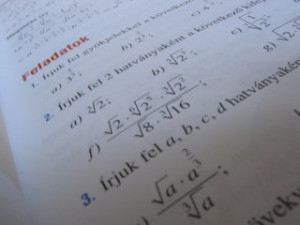If your child is applying to private schools, odds are she’ll be required to take either the ISEE (which stands for the Independent School Entrance Exam) or the SSAT (which stands for the Secondary School Admission Test). While these exams are similar in many respects, they are still different enough that the choice of which exam to take should be carefully considered.
School Preference
The first step in deciding which test your child should take is to check which exam the schools your child is applying to require or prefer. Many schools will happily consider either the SSAT or ISEE without any preference for one over the other. Others will explicitly require or prefer that you submit only one of the exams. Traditionally, New England boarding schools have required or preferred the SSAT, whereas New York City prep schools have required or preferred the ISEE. In recent years, however, a growing number of New York City private schools have begun accepting the SSAT as well as the ISEE, with no preference for either test.
Once you have a list of schools to apply to, call each school’s admissions office to find out their policies and preferences. While a school’s website might say they accept both exams, you might find when you call that they really prefer only one.
If a particular exam is required by a school, then the decision as to which test to take is already made for you. If a school prefers one exam to the other, it’s generally a good idea to stick with the exam that the school prefers. Not only do you look more interested and committed to that particular school when you submit their preferred test, but you also allow your child to be more easily evaluated in relation to the school’s other applicants, most of whom will have also taken the preferred exam.
While it’s generally best to follow a school’s exam preferences, there are circumstances in which it might be better to submit a different exam. If a school prefers the ISEE to the SSAT, but your child performs significantly higher on the SSAT than on the ISEE, then taking and submitting the SSAT would generally be wise as it would result in a stronger application. If your child is applying to nine schools that prefer the SSAT but only one that prefers the ISEE, you might also decide to forego the ISEE in favor of the SSAT, unless of course the ISEE school is a top choice.
If the schools to which you’re applying accept both exams, read on to learn the critical differences between them.
Critical Differences
When it comes to choosing which test to take, there are two major issues to consider. The first is whether your child tends to perform better in verbal or quantitative work, and the second is her level of testing anxiety.
If your child usually performs better in English and reading than in math, the SSAT might be a better choice. If math is your child’s strong point, on the other hand, then the ISEE might be better for her. The verbal section of the SSAT is more difficult than that of the ISEE, whereas the math section of the ISEE is more difficult than that of the SSAT.
What’s more difficult about SSAT verbal? The vocabulary tested tends to be more advanced, for one. The vocabulary is also tested partly through the use of analogies, which are much more reasoning intensive and difficult than the sentence completion question format the ISEE uses to test vocabulary. On the reading comprehension section, passages on the SSAT include both nonfiction and fiction, whereas the ISEE tests only nonfiction. This can make the SSAT more difficult for students who aren’t strong fiction readers.
SSAT verbal isn’t only more difficult than ISEE verbal—it also makes up much more of the total exam score. Even though the SSAT features two math sections and two verbal sections, two-thirds of the cumulative SSAT score is devoted to the sections testing verbal ability: there is a “reading,” “verbal” and “quantitative” score. The ISEE, on the other hand, breaks scores down evenly into two verbal (“verbal reasoning” and “reading comprehension”) and two quantitative scores (“quantitative reasoning” and “mathematics achievement”).
Mathematics doesn’t only feature more prominently in the ISEE score, but it’s also more difficult than on the SSAT. It’s important to note that this is a fairly recent change—the ISEE math section was revamped a few years ago, before which time it was much easier.
Whereas topics on SSAT math are usually pretty basic and stay within the grade levels of the test taker, the ISEE now tests some math that is often a few years more advanced than what a typical high school applicant will have been exposed to. This includes some 10th and 11th grade Algebra II and pre-calculus, such as matrices and vectors, as well as Trigonometry. These topics aren’t tested in a very challenging way and they can be learned, but they do pose an added hurdle for a student preparing for the ISEE.
ISEE math questions are more difficult than SSAT math questions not only because they can involve higher level math, but also because the problems themselves are often more complex and require more extensive critical reasoning. There is also significantly less time provided to solve each of these questions: either 57 or 51 seconds, depending on the section, whereas the SSAT provides 72 seconds per math question. This is the only area where the two exams differ significantly with respect to timing.
Testing Anxiety and Retakes
The second major difference you should consider when choosing between the ISEE and SSAT is your child’s level of testing anxiety. Students can only take the ISEE once every six months, whereas there is no limit on the number of times they can take the SSAT. Because the ISEE can only be taken once an application to a school has been formally initiated, this essentially means that that there is only one opportunity for the student to take the exam, generally in either December or January of the application year.
Some students will have no problem (and will probably welcome!) sitting for the test only once. For other students, however, the one-shot, make-or-break nature of the ISEE can create a burdensome amount of anxiety that can hinder performance on the actual exam. This can happen even among students who aren’t generally prone to testing anxiety. While this anxiety can be mitigated through taking multiple timed practice tests and by techniques aimed at relieving anxiety, it is something that must be considered before electing to take the ISEE.
The ability to retake the SSAT offers other benefits beyond simply mitigating test day anxiety. A student can take the test more than once and then choose which scores to send to schools, opting to report only their highest scores. Many schools will even “superscore” SSAT results, combining the highest individual section scores from across testing dates. Because students have more chances to take the exam, and because scores tend to fall within a range on any given sitting, taking the test more than once can help students earn higher scores than they might otherwise achieve sitting for the exam only once.
Other Differences
The ISEE and SSAT vary in a few other minor respects. The SSAT has a guessing penalty, whereas the ISEE does not. Both feature similar essay prompts (neither of the essays are scored, they are merely sent to the schools), but the ISEE provides an extra five minutes for the essay assignment. These types of differences, however, are very minor when compared to the relative difficulty levels of the verbal and math portions of each test and the difference in retake options. They are highly unlikely to cause any significant difference in a student’s scores on one test versus the other.
Still Not Sure Which To Take?
If you’re still not sure which test would be best for your child, ask them to take an official practice test for each. This will allow you to both compare their scores on two exams and find out which exam your child feels more comfortable taking. While most students usually do comparably well on both tests, some do perform stronger on one test in particular. Also, if you find that your child has a preference for one exam, this might help motivate them to put the necessary time into preparing.
What About Taking Both?
While the ISEE and SSAT are separate tests with a few critical differences, they are also very similar in many ways. Both test vocabulary, reading comprehension and general mathematics and feature many similar question types. The work done to prepare for one test will absolutely help a student on the other test. It is generally best to focus on one exam, but because the tests are so similar there is little harm in letting your child sit for both tests. If the schools to which your child is applying will accept either exam and your child is motivated to sit for both, she could do so and then submit the higher of the two scores. It’s important, however, to make sure your child is thoroughly prepared for at least one of the two exams. If your child doesn’t need to take both exams in order to fulfill school requirements, then there is no generally need to sit for both unless your child is motivated to do so.
Recap
For many students, the decision of which test to take will already be made for them by the schools to which they are applying. If that is not the case, then you should carefully consider how these critical differences between the ISEE and SSAT might play to your child’s own strengths and weaknesses. It’s always a good idea to take an official practice exam for each test to see if your child does better on and/or prefers one of the two tests. Officially sitting for both tests is an option, but it’s generally not necessary unless required by the schools your child is applying to or unless your child is especially motivated to do so.

